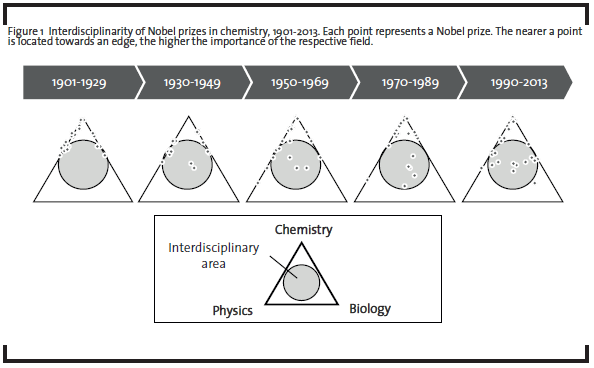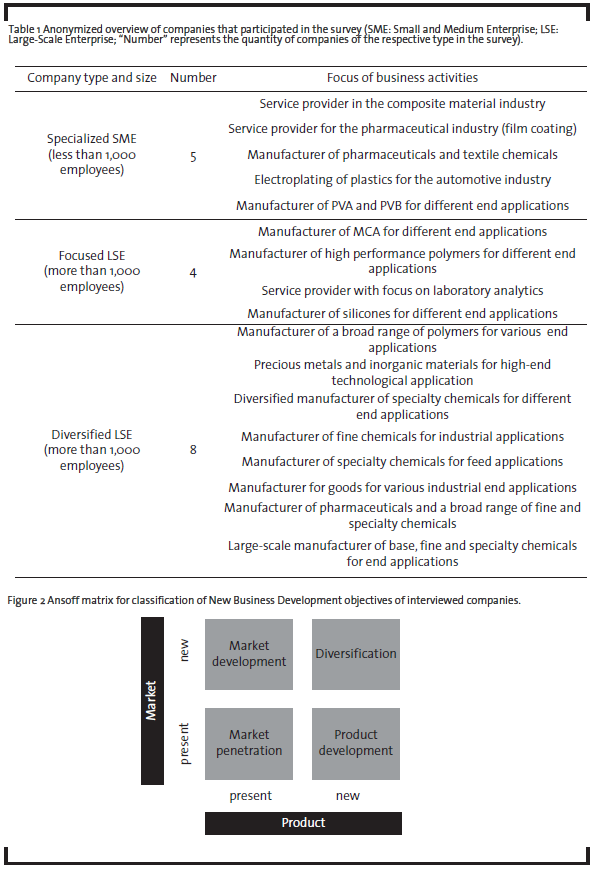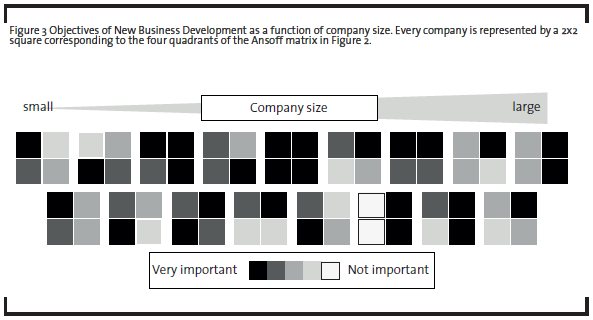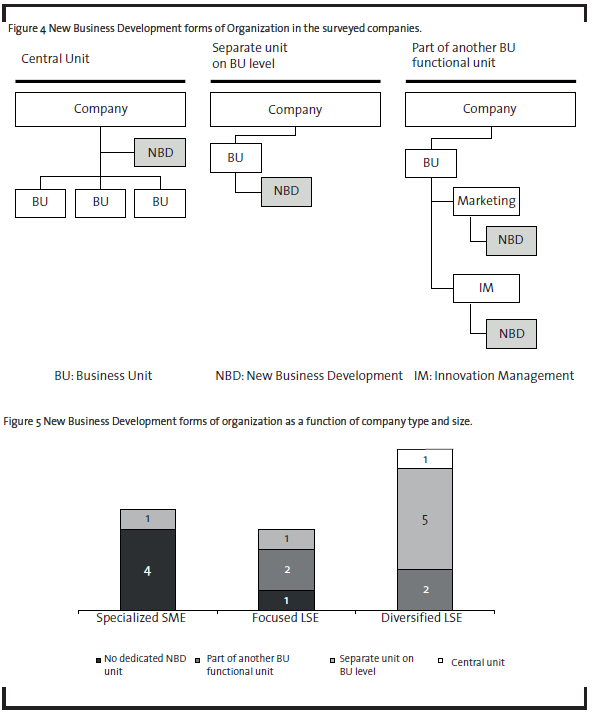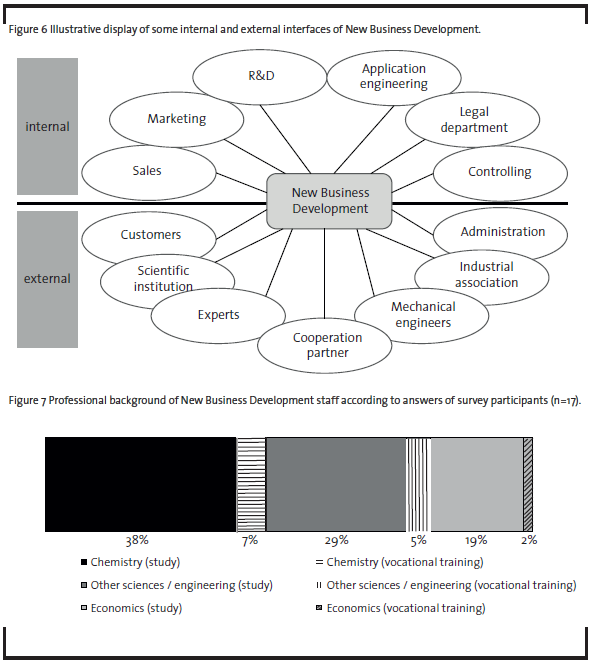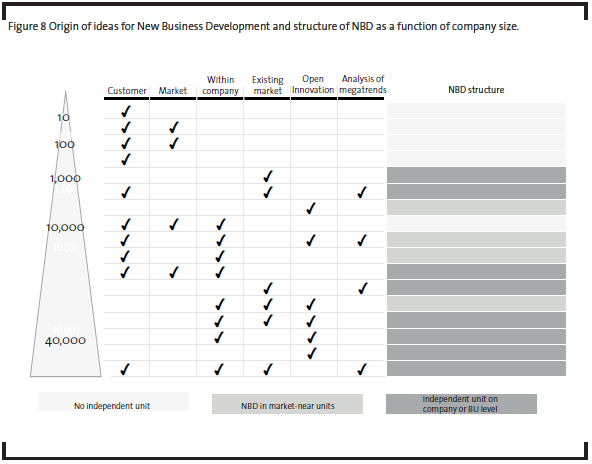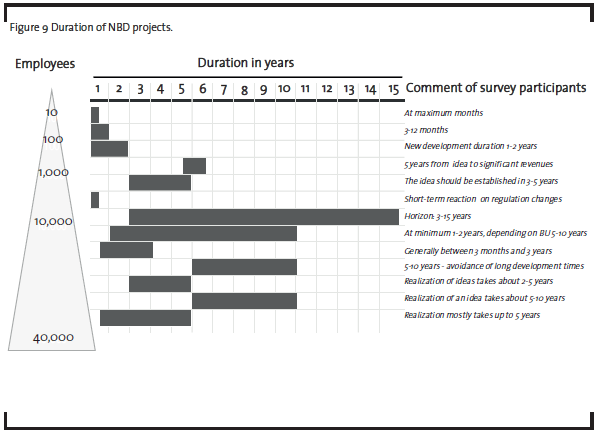On the current practice of New Business Development in the German chemical industry
The results of a survey on the practice of new business development conducted in 17 chemical industry companies and related business sectors, such as service providers, are presented in this article. The objectives and organizational setup of New Business Development were found to be exceptionally heterogeneous and to cover a broad spectrum. The differentiation between New Business Development and Innovation Management was also not consistent between the companies. All the companies underlined the importance of technical and scientific know-how for new business development staff, but also emphasized the relevance of interdisciplinary competencies at the interface between natural science and business. Small companies follow a rather opportunistic New Business Development approach without dedicated organizational structures. Larger companies, on the other hand, employ a Stage- Gate process and largely derive their ideas from megatrends. Differences between small and larger companies are discussed in the article at hand.
1 Introduction
Chemical companies are currently facing everincreasing competitive pressure in their market environment. Some of the drivers for this increasing competitive pressure are the globalization of value chains (CHEMonitor, 2014), the shorter product life cycles (Roland Berger, 2014), as well as with the faster commoditization of products, and shareholder’s expectations of publicly listed companies. As a reaction to this competitive pressure, we observed that in the last decade many companies have established dedicated functional or organizational units that are responsible for “New Business Development” (NBD). Compared to the more “traditional” units responsible for R&D and innovation management, NBD is not only responsible for new product development within the existing market environment of the company, but also deals with the development of (new) business activities along the whole value chain (concerning e.g., marketing, service, customer access, business model) (BASF, 2014; Clariant, 2014; CABB AG, 2014; Freudenberg, 2014; von Delft et al., 2013; Böcking et al., 2013). While there is no clear definition of New Business Development in the scientific literature, most authors so far seem to agree that NBD focuses on development of business activities outside the existing boundaries of a company (Karol et al., 2002a; Klumpp/Koppers, 2009). Karol et al. relate New Business Development for a company with “growth opportunities [that] lie outside both their current product/technology base and those markets/ customers they currently serve” (Karol et al., 2002). Klumpp and Koppers emphasize that “Business development […] aims at a change in the current portfolio and can be seen as an innovation in regards to technologies or business models” (Klumpp/Koppers, 2009). In the context of this article we propose the following working definition “New Business Development is the process of identification, evaluation and establishment of new business areas of a company”.
In order to get an impression of the current practice of New Business Development in the chemical industry, we conducted expert interviews with 17 companies of the chemical industry and their related areas (such as, e.g., service providers). We hypothesized that differences exist in the practice of New Business Development in the companies, and that there should be major differences between small and larger companies. New Business Development in the Chemical Industry has already been addressed in the scientific literature (Karol et al. 2002a; Karol et al. 2002b). However, to our knowledge there is no investigation or discussion of the differences in New Business Development in the Chemical Industry between smaller and larger companies in the scientific literature so far.
A further aspect to be examined in the survey were the competencies required for staff working in New Business Development. In this context it is interesting to note that as early as 1975, Cooper analyzed that it was not technical issues which led to failure of new product development, but rather shortcomings in “close to the markets activities” such as a poor market analysis, a lack of marketing effort or an inadequate compilation of a business plan (Cooper, 1975). One possible reason for this finding is the fundamentally different cultures of natural scientists (representing the technical competencies required for R&D) and economists (representing the market-near competencies required for e.g. marketing).
Another challenge for staff in New Business Development is the increasing interdisciplinarity in chemistry, as can be seen by analyzing the interdisciplinarity of Nobel prizes in chemistry from 1901 to 2013 (Figure 1).
2 Methods
We interviewed 19 experts from 17 companies of the chemical industry and related areas (e.g., service providers) about the topic New Business Development. The experts were managers of the units New Business Development (10 interviewees), innovation management (4), CEOs (3) and marketing manager (2).
The companies in the survey cover a broad range of company size as well as business activities and target markets (Table 1). This breadth was chosen in order to investigate the practice of New Business Development as a function of company size and business focus.
New Business Development activities can be generally classified using the Ansoff matrix (Ansoff, 1965) (Figure 2). Although this matrix is commonly focused on products, the underlying logic is transferable to other areas (such as services or business models).
All interviewees responded to a standardized questionnaire that contained open and closed questions on the following topics:
- Definition of New Business Development and differentiation from Innovation Management (two open questions in order to capture the breadth of the topic within the company).
- Objectives of New Business Development (open discussion and quantitative rating of the relative importance of the four quadrants of the Ansoff matrix).
- Organization of New Business Development (open question about the organizational setup, with focus on the hierarchical level on which NBD is executed in the company).
- Professional competence of staff (open and closed question in order to investigate the importance of technical competencies versus economic competencies).
- New Business Development process, origin of ideas and typical project duration (open questions).
The questions and the results are discussed in detail in the following section. All interviews were conducted either by phone or personally.
3 Results and Discussion
3.1 Objective and organization of New Business Development
All interviewees were asked to assess the individual fields of the Ansoff matrix according to their relative importance for their company. The results of this question are displayed in Figure 3.
Interestingly, all companies seem to have different prioritizations in the focus of New Business Development. This can be seen from the fact that all companies assessed the four quadrants of the Ansoff matrix differently. In the light of this result, it is less surprising that there is no single definition of New Business Development in the literature.
Furthermore, it can be seen in Figure 3 that diversification (development of new products for new markets) seems to become more important with increasing company size (the further one goes from left to right in Figure 3, the more often interviewees ranked the upper right quadrant of the matrix with “very important”). This result can be explained by the fact that the time-consuming and expensive development of new products and innovation constitutes an integral part of the competitive strategy of larger companies. They also have sufficient resources to fund the development of these new products, which is usually difficult to realize for small companies due to budget restraints.
Smaller companies, on the other hand, rather seem to focus on market penetration and – to a lesser extent – market development. This result is somewhat surprising, as market development also requires a large amount of resources. However, all the companies surveyed seem to hold their own definition of what “market development” specifically means. Smaller companies often defined “market development” in terms of “expanding into other geographical regions”, whereas larger companies also included “opening up of a previously unserved customer segment” (like, e.g., using PTFE [polytetrafluoroethlyene] for non-stick coating in frying pans – beyond traditional B2B market segments), which usually requires more resources.
However, beyond possible ambiguities as to the definition of the four quadrants of the Ansoff matrix, we think the survey results reflect first and foremost the broad diversity of different market segments and competitive environments which are characteristic for the chemical industry.
The organizational setup of New Business Development in the companies surveyed is also quite different. Some of the most frequently mentioned forms of organization are displayed in Figure 4. In addition, some companies reported that they do not have a dedicated NBD unit. This concerns mainly smaller companies where NBD is carried out directly by the CEO without a separate organizational unit.
For those companies that have a dedicated NBD unit, three different forms of organization can be distinguished, according to the hierarchical level where New Business Development is located. Firstly, there can be a central NBD unit for the whole company (Figure 4, left hand side) with a direct report to the top management of the entire company (for some small companies, NBD is actually executed by the CEO himself). Secondly, the NBD unit can be an individual organizational unit within one of the business units (Figure 4, middle). And thirdly, some companies reported forms of organization where the NBD function is part of another functional unit within the business unit, such as marketing or innovation management (Figure 4, right hand side).
These different forms of organization differ between smaller and larger companies (Figure 5). In focused SME, there is usually no dedicated NBD organizational unit (given the usual narrow market focus of these companies, NBD is often conducted on CEO level or as an additional task within other functional units), whereas larger companies usually execute NBD in a dedicated unit. Most diversified LSE in the survey reported to have a dedicated NBD unit within each business unit (due to the often specialized market focus of individual business units). In focused LSE, the organizational setup seems to depend on the market. One company with focus on one specific niche segment does not employ a dedicated NBD unit. Another company with focus on two individual niche products organizes its NBD in individual units on BU level (due to required technical knowledge in each individual end market). And two companies that focus on a larger variety of end markets employ NBD units as part of other BU functional units in other “market-near” activities (either marketing or application engineering).
From Figure 5 it could be inferred that the importance of more centralized organizational units seems to increase as a function of company size and diversity. Indeed, there is some anecdotal evidence from the survey that larger companies seem to further strengthen their activities in these longterm topics with dedicated organizational units that are positioned at a company level (not on BU level). These centralized units are responsible for strategic NBD portfolio management of the entire company. However, it is not possible to generalize this finding. For example, one diversified LSE reported that the existing centralized NBD unit was recently restructured into several NBD units in each business unit, due to different competitive and technological dynamics in the end markets served by the individual business units.
We think that it is also important to distinguish New Business Development from organizational functions that focus on long-term future trends (time horizon > 10 years) like the “Corporate Foresight” unit at Evonik (Evonik, 2014).
In this context, it is further important to note that the differentiation between New Business Development and Innovation Management is seen quite differently between different companies. The answers of the survey participants cover a broad spectrum, as can be illustrated by the following examples:
- “Innovation Management is a tool of New Business Development.”
- “Innovation Management is the development of new products and processes. New Business Development is rather located at the customer interface.”
- “Innovation Management rather focuses on existing products and processes.”
- “There is no distinction between New Business Development and Innovation Management.”
The large differences in the objectives of New Business Development and the differentiation towards Innovation Management probably reflect the broad spectrum of different markets in which the companies are active. Given that these markets differ with respect to many parameters (e.g., competitive dynamics, success factors, product life cycle duration) it is not surprising that a large variety of New Business Development models is established in the chemical industry. The differentiation between New Business Development and Innovation Management is also not unequivocal in the literature. However, it seems that the practice of Innovation Management is rather associated with product and process development within the existing business (Hauschildt/Salomo 2007), whereas New Business Development seems to focus on development of business opportunities outside the existing business, i.e. the upper right corner of the Ansoff matrix (Karol et al. 2002a).
3.2 Professional background of New Business Development staff
As already described above, New Business Development is a function with many interfaces within the company and outside the company (Figure 6). This requires staff with a broad set of skills, particularly communication skills as well as willingness and ability to learn.
In this context it is interesting to note that the majority of employees in New Business Development in the companies interviewed have a background either in chemistry / natural sciences or engineering (Figure 7). Most companies reported that a pure economics background would not be sufficient for successfully working in NBD, as might be underlined by the following exemplary quote:
“We have tried once to employ a pure economist in New Business Development. Unfortunately, this was not successful as he lacked the technical background in chemistry and natural sciences.”
However, most companies emphasized the importance of combining both technical expertise (chemistry) and economic know-how. It is therefore not surprising to find graduates with a PhD and further training in economics (e.g., Master of Business Administration, MBA). In addition, students who followed other interdisciplinary study courses at the interface of natural sciences and economics were also mentioned to hold the competencies required for New Business Development.
Furthermore, it seems that an academic degree is necessary in order to successfully work in New Business Development. One could hypothesize that this reflects the requirements of competencies like communication skills and abstract thinking which are mainly practised during an academic study course. Nevertheless, 15 percent of NBD employees the companies interviewed have followed vocational training and have no academic degree. They are mainly employed in smaller and medium-sized companies with flat hierarchies. In these cases, it was mainly the practical experience that represents a core competency of these employees for New Business Development.
The practical experience of NBD staff was also mentioned at larger companies. Besides the professional expertise (through vocational or academic training), customer and market know-how, combined with an established industry network (in order to quickly identify the experts for specific subjects related with an NBD idea) are critical success factors for employees in New Business Development.
3.3 New Business Development process
The companies in the survey with more than 500 employees apply a Stage-Gate process (Cooper, 2001) for management of their NBD projects. This process is usually adapted to the specific requirements of the company. One example of such an adapted process is DuPonts “business initiative process” (BIP) that has been described in the literature (Karol et al. 2002a; Karol et al. 2002b).
Companies with less than 500 employees do not usually follow an established and defined process and pursue a rather opportunistic approach towards New Business Development. A specific type of such a “pragmatic” approach has been described in the literature (Schlesinger et al. 2012).
The most important sources of ideas for New Business Development are given in Figure 8. Most companies derive their ideas from different sources. However, it can be seen that smaller companies seem to prefer their immediate customers as origins of ideas. Larger companies, on the other hand, derive their NBD ideas more out of long-term considerations (such as, e.g., out of megatrends). One possibility of deriving specific ideas for New Business Development would be the application of systematic patent analysis and mapping tools, as described in the literature (Seymour, 2008).
It can also be seen in Figure 8 that it is the larger companies that established a dedicated New Business Development unit as an independent functional organization with specific processes. This result emphasises once more that smaller companies seem to pursue a rather opportunistic approach towards New Business Development without such dedicated functional units.
Differences between smaller and larger companies can also be identified with respect to the duration of New Business Development projects (Figure 9). Whereas companies with up to 1,000 employees seem to favour short-term projects of 1-2 year duration, larger companies also execute projects with a duration of typically up to 10 years (in one case even up to 15 years).
This result is also not surprising, given that larger companies (as discussed before) are more capable of pursuing these long-term projects due to sufficient resources and capital. Smaller companies seem to focus on short-term, customer-driven projects centered on application development. Product development is followed to some extent in smaller companies, but, due to time and resource restraints, is not the common objective of NBD. And technology development, which requires an even larger amount of time and resources, is only pursued to a significant extent at larger companies.
4 Conclusion
In the work at hand, several aspects of New Business Development in the chemical industry and related areas are investigated. In this context, differences depending on company size were analyzed.
New Business Development represents a heterogeneous subject in the chemical industry as different definitions, objectives, organizational structures and processes exist in practice. Smaller companies do not usually have dedicated NBD units, both due to resource restraints, and usually to narrow market focus. For larger companies (>1,000 employees) the structure of the NBD organization seems to depend on the diversity of end markets served. With increasing company size and diversity of the product portfolio, a dedicated NBD organizational unit seems to become more important. However, given the rather small sample size and the differences of end markets addressed by the companies (Table 1), we cannot conclude to which extent the individual market segment influences the setup of NBD in the chemical industry. We would encourage further research in this field with a larger sample size in order to better understand this topic.
With respect to the competencies required it is important to note the relevance of technical knowhow. Of particular importance are also competencies at the interface of different disciplines (such as chemistry and economics), which can be obtained through additional academic training in economics (such as an MBA) or in an interdisciplinary study course.
Smaller companies pursue a pragmatic and somewhat opportunistic approach towards New Business Development, which can be inferred from the fact that the end customer is often the major origin of ideas and that there is no dedicated process for execution of NBD projects. Larger companies, on the other hand, focus more on long-term projects (as derived from megatrends, for example) and usually follow a Stage-Gate process for execution of NBD projects.
However, the results presented in this work should be taken with caution, as the total number of companies that participated in the survey was quite low (n=17). Therefore, the results cannot be seen as statistically significant, but should rather be interpreted as a trend study. It is therefore quite possible that the specific situation in an individual company is considerably different from the results outlined in this article.
What is the implication of these results for management of chemical companies and service providers such as consulting companies? In our view, these results can be of use in two major dimensions.
Firstly, this study may sensitize decision makers in the chemical industry for the topic New Business Development. We currently seem to face the situation where it is not only the large chemical companies that implemented a dedicated unit, but that also small and medium-sized companies are beginning to enter the field of New Business Development. So each company should carefully ask itself to which extent this topic is already addressed within the current organization – and investigate the necessity of creating a dedicated New Business Development unit in order to stimulate long-term sustainable growth and competitiveness. In this context, it seems important for us to note that all companies have identified NBD as a prerequisite for establishing long-term competitive advantage in the industry and market environment.
Secondly, the results may help managers responsible for New Business development to benchmark their own practice compared to other companies displayed in this work with respect to the various areas of objectives, organizational setup, processes or competencies required. This may help to heighten the activities of each individual company and to ensure that the application of New Business Development will further evolve in the chemical industry.
Therefore, although New Business Development itself can still be seen as an emerging topic within the chemical industry, some structural characteristics and differences already become visible in the market place. It will be important and interesting to follow the development of these models in upcoming years in order to see which of these models will continue to prosper and whether there will be approaches towards New Business Development that may not prevail. In any case, it will hardly be possible for decision makers in the chemical industry to circumvent this topic for their company.
Acknowledgements
The authors would like to thank Catherine Croghan (Fresenius University of Applied Sciences) for proofreading.
References
Ansoff, I. (1965): Corporate Strategy, McGraw-Hill.
BASF (2014): New Business Development in der BASF, available at http://www.basf.com/group/produkte-und-branchen/new-business-development, accessed March 8th, 2014.
Böcking, J., Bulmahn, M., and Guggolz, E. (2013): “Ein effizienter Weg, um neue Technologien an Bord zu nehmen”, Nachr. Chem., 9, 912-915.
CABB AG (2014): Neue Horizonte entdecken, available at http://www.cabb-chemicals.com/de /new-business-development.html, accessed March 8th, 2014.
CHEMonitor (2014): Die Chancen der Globalisierung überwiegen, available at http://www. chemanager-online.com/news-opinions/maerkte/chemonitor-die-chancen-der-globalisierungueberwiegen, accessed March 8th, 2014.
Clariant (2014): New Business Devlopment at Clariant, available at http://www.clariant.com/C12579EC0046869F/vwWebPagesByID/ A9C7AB411A997228C12579EC002C6E2A, accessed March 8th, 2014.
Cooper, R.G. (1975): Why new industrial products fail, Industrial Marketing Management, 4, 315- 326.
Cooper, R.G. (2001): Winning at new products – accelerating the process from idea to launch, 3rd edition, Perseus Publishing.
Evonik (2014): Corporate Foresight website, available at http://www.creavis.de/sites/creavis/de/besondere-aktivitaeten/corporate-foresight/Pages/default.aspx, accessed April 28th, 2014.
Freudenberg (2014): New Business Development at Freudenberg, available at http://www.fntkg.de/new-businesses/new-business-development, accessed March 8th, 2014.
Hauschildt, J., and Salomo, S. (2007): Innovationsmanagement, 4th Edition, Verlag Franz Vahlen, Munich.
Karol, R. A., Loeser, R. C., and Tait, R. H. (2002a): Better New Business Development at DuPont – I, Research-Technology Management, January- February 2002, 24-30.
Karol, R. A., Loeser, R. C., and Tait, R. H. (2002b): Better New Business Development at DuPont – II, Research-Technology Management, March-April 2002, 47-56.
Klumpp, M., and Koppers, C. (2009): Integrated Business Development, ild Institut für Logistik- & Dienstleistungsmanagement, Schriftenreihe Logistikforschung, 7 (December).
Roland Berger (2014): press release “Mastering product complexity”, available at http://www.rolandberger.de/pressemitteilungen/512-press_archive2012_sc_content/Komplexitaetszuwachs_bei_Produkten_und_Komponenten.html, accessed March 8th, 2014.
Schlesinger, L. A., Kiefer, C. F., and Brown, P. B. (2012): New Project? Don’t Analyze – Act, Harvard Business Review, 90 (3), 154-158.
Seymour, R. (2008): Platinum Group Metals Patent Analysis and Mapping, Platinum Metals Rev., 52 (4), 231-240.
von Delft, S., and Kortmann, S. (2013): Neue Geschäftsmodelle – neue Möglichkeiten, Nachr. Chem., 5, 545-547.
